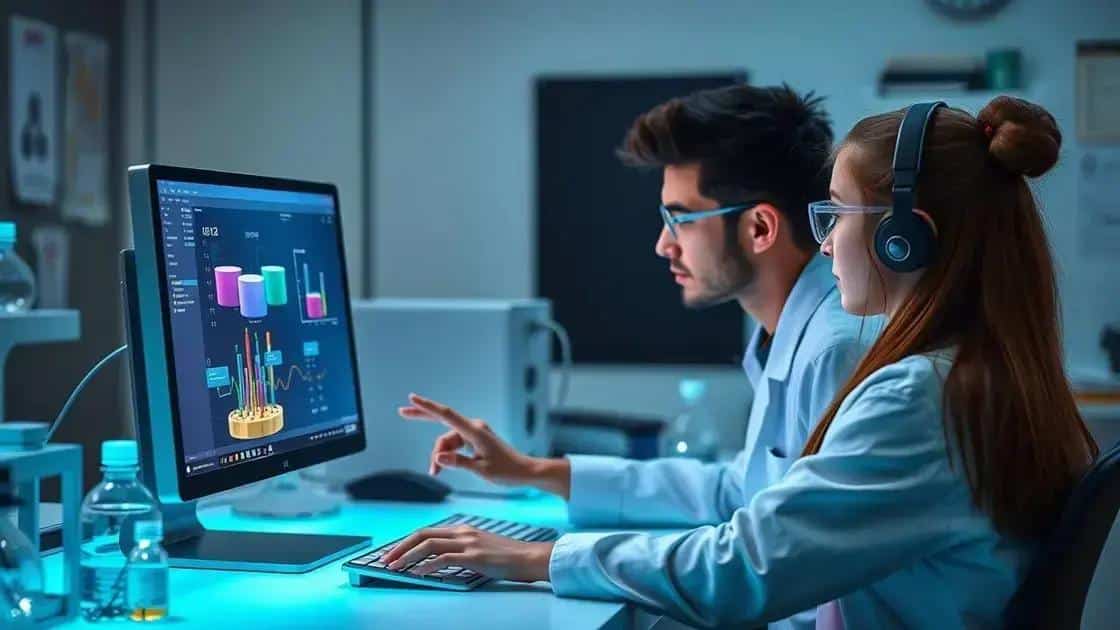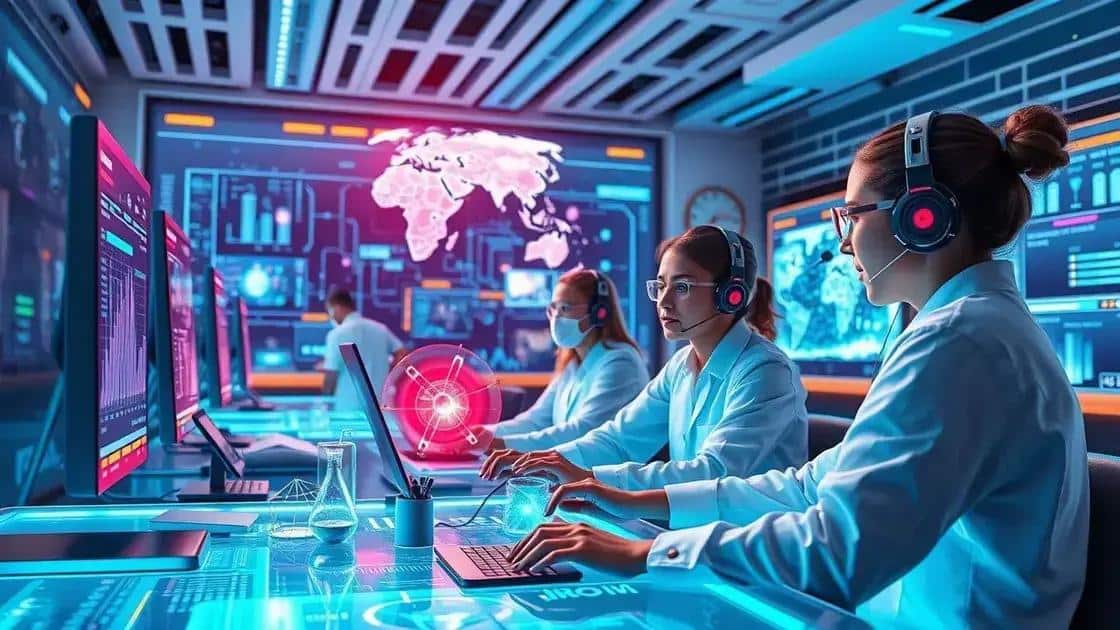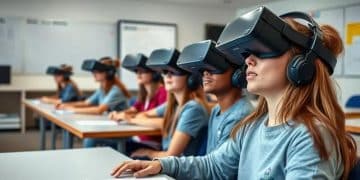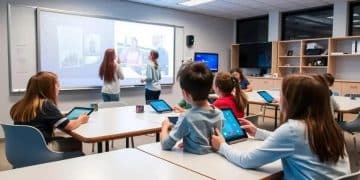Virtual lab simulations trends reshaping education

Virtual lab simulations enhance education by providing interactive, accessible, and realistic learning experiences, utilizing technologies like AI and 3D modeling to prepare students for real-world applications.
Virtual lab simulations trends are playing an essential role in modern education, providing students with hands-on experience in a virtual environment. Have you ever considered how these simulations enhance learning outcomes?
The evolution of virtual lab simulations
The evolution of virtual lab simulations has transformed how students interact with science and technology. These engaging tools allow learners to experiment and explore concepts without the limitations of physical labs. As technology progresses, these platforms have become more sophisticated, enriching the educational experience.
Advancements in Technology
Today’s virtual lab simulations incorporate cutting-edge technologies such as artificial intelligence, 3D modeling, and immersive environments. By leveraging these innovations, educators can design more effective learning experiences that cater to diverse learning styles.
- Artificial Intelligence: Provides personalized feedback to students.
- 3D Modeling: Enables realistic representations of complex systems.
- Immersive Environments: Creates engaging scenarios for interactive learning.
With these advancements, virtual labs become not just a replacement for physical experiments but enhance understanding and retention of knowledge. Students can work at their own pace, revisiting simulations as needed, which encourages exploration and a deeper grasp of underlying principles.
Changing Educational Landscapes
The rise of online learning platforms has also contributed to the growth of virtual lab simulations. As more institutions adopt blended or fully online models, the importance of remote labs increases. These simulations bridge the gap for students who may lack access to traditional lab settings.
Today, virtual labs promote collaboration among international students, allowing them to work on projects together in real-time. This not only nurtures teamwork but also fosters a global perspective in problem-solving. The potential for such collaborative experiences in a safe, experimental space is invaluable for students in any scientific field.
Benefits of using virtual labs in education

The benefits of using virtual labs in education are significant and multifaceted. These labs offer unique advantages that enhance student learning experiences and outcomes. Through interactive simulations, students can engage in hands-on experiments without the need for physical materials.
Enhancing Engagement
One major benefit is increased student engagement. Virtual labs are designed to be interactive, making them more appealing to learners. When students use simulations, they often find the experience more exciting than traditional learning methods.
- Interactive Elements: Students can manipulate variables and see real-time results.
- Gamification: Some virtual labs incorporate game-like features, encouraging exploration.
- Accessibility: Students can access labs anytime and anywhere, allowing for flexible learning.
This level of engagement not only motivates students but also promotes deeper understanding of complex concepts. The ability to visualize processes and conduct experiments in a risk-free environment cultivates curiosity and creativity.
Cost Efficiency
Another key benefit is cost efficiency. Traditional labs often require expensive equipment and materials that can be challenging for educational institutions to provide. In contrast, virtual labs eliminate these costs, providing an effective alternative.
Using virtual simulations allows students to conduct a variety of experiments without the limitations of a physical lab. This enables educators to design diverse curricula without worrying about resource scarcity. Moreover, virtual labs can accommodate larger groups of students simultaneously, maximizing the use of resources.
Furthermore, they can be updated easily to stay current with scientific advancements, ensuring that students always have access to the latest technologies. Overall, the benefits of using virtual labs extend beyond just saving costs; they also enhance the quality of education.
Key technologies driving virtual lab innovations
Key technologies driving virtual lab innovations play an essential role in transforming the educational landscape. These technologies empower both educators and students by creating immersive, hands-on learning experiences. As technology continues to evolve, the integration of various tools enhances the capabilities of virtual labs.
Artificial Intelligence
Artificial intelligence (AI) is a cornerstone technology in virtual labs. It enables personalized learning experiences, adapting to the unique needs of each student. AI can analyze a student’s performance and tailor simulations accordingly, providing targeted feedback and suggestions for improvement.
- Adaptive Learning: AI adjusts problems based on skill level.
- Instant Feedback: Students receive real-time assessments.
- Enhanced Engagement: AI-driven games boost participation.
This customized approach not only makes learning more effective but also keeps students engaged in the material. Students can explore at their own pace and revisit complex topics until they feel confident.
3D Modeling and Simulations
3D modeling plays a critical role in making virtual labs visually engaging. By using realistic graphics, students can better understand scientific concepts. This technology allows for the creation of lifelike simulations that replicate real-world scenarios.
3D models can be manipulated, giving students the chance to experiment with different variables. This hands-on approach fosters exploration and allows students to observe outcomes in a virtual environment.
The ability to visualize challenging concepts through interactive 3D models encourages deeper learning. As students navigate through these simulations, they gain valuable insights that traditional methods may not provide.
Virtual Reality (VR) and Augmented Reality (AR)
Virtual reality (VR) and augmented reality (AR) are revolutionizing the way experiments are conducted in educational settings. VR immerses students in a completely virtual environment where they can interact with elements in a simulated lab. In contrast, AR overlays digital information onto the real world, enhancing the learning experience.
Both technologies offer unique opportunities for hands-on exploration, fostering problem-solving skills and critical thinking. Students can conduct experiments that would be impossible or unsafe in a physical lab. This innovative approach promotes active learning and allows learners to experience science in a whole new way.
Future predictions for virtual lab simulations

Future predictions for virtual lab simulations indicate a rapidly evolving landscape in education technology. As innovations continue to emerge, the way students interact with virtual labs is expected to change dramatically. These advancements will enhance learning experiences and outcomes, preparing students for the challenges of the future.
Increased Accessibility
One significant trend is the increased accessibility of virtual lab technologies. As internet connections improve globally, more students will be able to access high-quality simulations from various locations. This democratization of education will allow learners from diverse backgrounds to engage in complex scientific experiments without the limitations of physical resources.
- Affordable technologies will become widely available.
- Schools in remote areas will gain access to virtual laboratories.
- Global collaboration among students will increase.
As a result, students will have the opportunity to collaborate with their peers worldwide, fostering cultural exchange and shared learning experiences. This will enrich their understanding of global scientific issues.
Integration with Emerging Technologies
The integration of emerging technologies like artificial intelligence and machine learning will innovate how simulations are created and used. These technologies will enable more personalized learning experiences. Students will receive tailored support based on their needs and preferences.
For instance, AI could provide hints or adjust simulation parameters based on the student’s progress. Additionally, incorporating advanced analytics will help educators track performance trends, informing future lesson plans and content adjustments.
Real-World Applications
Future predictions also suggest that virtual lab simulations will expand to include more real-world applications. Students will likely engage in simulations that mirror real-life scenarios, such as environmental science challenges or health crises. This hands-on approach can prepare students for future careers in STEM fields.
Furthermore, educational institutions may partner with industries to create simulations based on current projects and research. This collaboration can enhance relevancy in education, ensuring students are well-equipped for the job market.
Overall, the future of virtual lab simulations is bright, promising to transform how education is delivered and experienced.
As we look forward, virtual lab simulations are set to revolutionize the educational experience. These advancements will not only make science more accessible but will also enhance engagement and deeper understanding among students. With technologies like artificial intelligence and 3D modeling, learners can explore and experiment in ways that were previously unimaginable. By integrating real-world applications and promoting collaboration, the future of education seems bright. In the years to come, virtual labs will continue to play a key role in shaping the next generation of scientists, engineers, and informed citizens.
FAQ – Frequently Asked Questions About Virtual Lab Simulations
What are virtual lab simulations?
Virtual lab simulations are digital environments that replicate real-life laboratory experiments, allowing students to explore and learn without physical materials.
How do virtual labs enhance student learning?
Virtual labs engage students by providing interactive experiences where they can manipulate variables and receive instant feedback, fostering deeper understanding.
Can virtual labs be used in remote learning?
Yes, virtual labs are ideal for remote learning as they can be accessed from anywhere with an internet connection, making science education more accessible.
What technologies drive innovations in virtual labs?
Key technologies include artificial intelligence for personalized learning, 3D modeling for realistic simulations, and virtual and augmented reality for immersive experiences.





